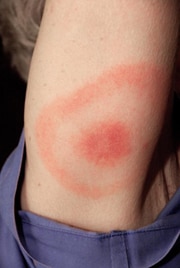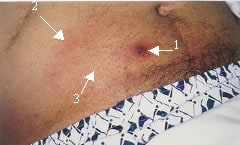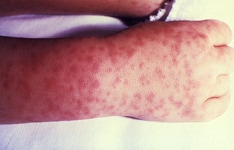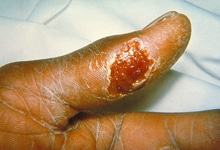Many tick borne diseases
can have similar signs and symptoms. If you have been bitten by a tick
and develop the symptoms below within a few weeks, a health care
provider should evaluate the following before deciding on a course of
treatment:
- Your symptoms
- The geographic region in which you were bitten
- Diagnostic tests, if indicated by the symptoms and the region where you were bitten
- Fever/chills: With all tick borne diseases, patients can experience fever at varying degrees and time of onset.
- Aches and pains: Tick borne disease symptoms include headache, fatigue, and muscle aches. With Lyme disease you may also experience joint pain. The severity and time of onset of these symptoms can depend on the disease and the patient's personal tolerance level.
- Rash:
- In Lyme disease, the rash may appear within 3-30 days, typically before the onset of fever. The Lyme disease rash is the first sign of infection and is usually a circular rash. This rash occurs in approximately 70-80% of infected persons and begins at the site of a tick bite. It may be warm, but is not usually painful. Some patients develop additional EM lesions in other areas of the body several days later.
- The rash of (STARI) is nearly identical to that of Lyme disease, with a red, expanding "bulls eye" lesion that develops around the site of a lone star tick bite. Unlike Lyme disease, STARI has not been linked to any arthritic or neurological symptoms.
- The rash seen with Rocky Mountain spotted fever (RMSF) varies greatly from person to person in appearance, location, and time of onset. About 10% of people with RMSF never develop a rash. Most often, the rash begins 2-5 days after the onset of fever as small, flat, pink, non-itchy spots (macules) on the wrists, forearms, and ankles and spreads to the trunk. It sometimes involves the palms and soles. The red to purple, spotted (petechial) rash of RMSF is usually not seen until the sixth day or later after onset of symptoms and occurs in 35-60% of patients with the infection.
- In the most common form of tularemia, a skin ulcer appears at the site where the organism entered the body. The ulcer is accompanied by swelling of regional lymph glands, usually in the armpit or groin.
- In about 30% of patients (and up to 60% of children), ehrlichiosis can cause a rash. The appearance of the rash ranges from macular to maculopapular to petechial, and may appear after the onset of fever.

"Target" lesion on patient with Lyme disease.

Patient with STARI.
1. Site of tick bite
2. Red, radial, expanding edge of rash
3. Central clearing
Photograph used with permission from the Journal of Infectious Diseases.

Late (petechial) rash on hand and forearm in patient with Rocky Mountain spotted fever.

An ulcer caused by tularemia.

No comments:
Post a Comment